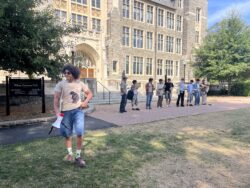“We are at our very best when we recognize our responsibility to one another,” university president John DeGioia said on Wednesday. “The work we are able to do today has been made possible by the efforts of those who have come before us, and by the moments in time when our community has come together in extraordinary ways.” He stood in the HFSC social room, where alumni from across the country gathered with present students and faculty to celebrate the 10th anniversary of the Out for Change Campaign.
This 2007 student movement urged the university to provide improved support for LGBTQ students, eventually leading to the establishment of the LGBTQ Resource Center in the spring of 2008. Wednesday’s event was, in part, a celebration of the successes of the center, which for years has been an important community for LGBTQ students on campus. When DeGioia rose to give his welcoming remarks on Wednesday, he faced a room of students and faculty dedicated to LGBTQ advocacy at Georgetown, many involved in the center.
A decade earlier, on Oct. 24, 2007, DeGioia stood in the ICC Auditorium to address a similar audience. That fall, two hate crimes related to sexual orientation had rattled the student body. In one incident, an assailant attacked a Georgetown undergraduate on campus, shouting anti-gay slurs. The Bias Reporting System data at that time indicated that prejudice related to gender or sexual orientation motivated 70 percent of all hate crimes at Georgetown.
In the wake of the hate crimes, students protested what they described as a lack of support for LGBTQ students on campus, and a vague, insufficient response protocol for bias incidents. From these demonstrations rose the Out for Change campaign, whose trademark was a yellow T-shirt with the words “I Am.” In one now-infamous incident, students alleged that when they marched to Healy Hall to deliver their campaign’s demands, security personnel selectively refused to allow any person wearing an Out for Change shirt to enter the building.
The campaign pushed for what student advocates had been demanding for years: additional resources for LGBTQ students, information sessions on LGBTQ issues, and a new, more transparent protocol for hate crimes. But for Julia Reticker-Flynn (SFS ’08), who was a senior involved at the time, Out for Change was about more than just policy. “The campaign was really twofold. It was to advocate for a stronger set of resources and support for LGBTQ students, but also to advocate for a culture shift on campus,” she said. The campaign asked for support from the student body, as well as the administration.
They received it from both. “I think there was widespread student support for LGBTQ students that we honestly hadn’t seen before at the university,” Reticker-Flynn said, noting that the campaign was not made up of a singular group, but rather a coalition of student organizations, alumni, and faculty.
Jason Resendez (COL ’08), who served on the board of GU Pride at the time, said this solidarity was crucial to the success of the campaign. “Hoyas from all walks of life joined together and demanded the institution live up to the values it’s so comfortable printing on brochures and sign posts,” Resendez wrote in an email to the Voice.
DeGioia’s speech that October promised action on their demands. It was a substantial victory for the campaign.
“I would like to propose that our community work together on a more comprehensive initiative to strengthen Georgetown’s approach to addressing the needs of LGBTQ students,” DeGioia said in 2007. “I would like us to get to work right away.” That evening, he went on to establish three working groups on LGBTQ issues on campus. Their subsequent reports shaped the university’s response to the campaign.
“In many ways, it was what we were looking for,” Reticker-Flynn said of DeGioia’s statements. “I think many of us were really pleasantly surprised at the very public and very proactive stance that DeGioia voiced during that meeting.”
In the year that followed, the university established the LGBTQ Resource Center, complete with two full-time staff members, becoming the first Catholic institution in the nation to do so. The administration overhauled the bias incident reporting system, and changed university police training protocol.
Sivagami Subbaraman, who was hired by the university to lead the resource center in 2008, believes the campaign’s success was representative of Georgetown’s student culture. “The way I see it, there is always a call by students about a justice issue,” she wrote in an email to the Voice. “In turn, the institution responds to this call in a way that is thoughtful and strong, and leads to institutional change and transformation. I do believe that this call and response is at the heart of the Georgetown experience.” For Subbamaran, to honor the Out for Change campaign is to honor the work of students going back decades.
LGBTQ student organizations on campus long precede the Out for Change campaign. In 1980, the Gay Rights Coalition of Georgetown Law and the Gay People of Georgetown University sued the university for discrimination, arguing that Georgetown’s refusal to grant them recognition and access to facilities and funding was illegal. They won a partial victory in 1987, when the judge ruled that the university must grant them the same access to resources as other organizations, although not official recognition.
By 2002, Georgetown University Pride had gained university recognition, and Georgetown had hired a part-time LGBTQ resource coordinator. And since 2007, under Subbaraman’s leadership, the scope of the LGBTQ resource center has expanded. The center now offers weekly coffee hours, hosts speakers, and furthers campus advocacy work.
Wednesday’s event recognized, too, the work of current students dedicated to LGBTQ issues on campus. Several LGBTQ student groups will host a Queer Leadership Summit for the first time this year. The resource center is also launching a mentorship program for new students to expand the center’s campus presence.
Grace Smith (COL ’18) helped launch this new mentorship program. She spoke of the importance of Out for Change for members of the resource center, old and new. “The Out for Change campaign celebration will remind the wider Georgetown community and the campus queer community that our origins are in resistance, that our resilience has defined us, and that our strength lies in collective, compassionate action,” she wrote in an email to the Voice. “We are because we were and always have been.”
Beginning Oct. 7, the LGBTQ Resource Center will celebrate OUTober, an annual celebration of LGBTQ identity, featuring speakers, forums, and celebrations throughout the month. The kick-off event is Coming Out Day. As is Georgetown tradition, students will run proudly that afternoon through an open door in Red Square, sporting bright Out For Change-inspired T-shirts that read, “i am.”
Image Credit: Andrew Sullivan






